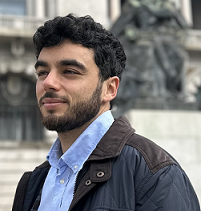Dr. Azhar Imran Mudasir
Air University, Pakistan

Dr. Azhar Imran Mudasir is an Assistant Professor at the Department of Creative Technologies, Faculty of Computing & Artificial Intelligence, Air University, Islamabad, Pakistan. He has completed his doctoral degree in Software Engineering from the Beijing University of Technology, China, and his master's degree in Computer Science from the University of Sargodha, Pakistan. He worked as a Senior Lecturer at the Department of Computer Science, University of Sargodha, Pakistan, from 2012 to 2017. He is a renowned expert in Image Processing, Healthcare Informatics, and Social Media Analysis. He is a regular member of IEEE and has contributed with 60+ research articles in well-reputed international journals and conferences. He is the editorial member and reviewer of various journals, including IEEE Access, MDPI Cancers, Applied Sciences, Mathematics, Springer Visual Computer, Talyor and Francis: Biomedical Imaging and Visualization, Multimedia Media Tools & Applications, IGI Global and Journal of Imaging, etc. Dr. Azhar has over 12 years of national and international academic experience as a Full-Time Faculty, teaching Software Engineering and core computing courses. Dr. Azhar has delivered guest talks and conducted seminars and trainings at numerous national and international forums in the past. He has contributed to multiple international conferences in diverse roles (keynote speaker, technical/ committee member, registration, speaker, etc.). His research interests include Image Processing, Social Media Analysis, Medical Image Diagnosis, Machine Learning, and Data Mining. He aims to contribute to interdisciplinary research of computer science and human-related disciplines.
Speech Title: The Role of AI in Healthcare:- Hope v/s Hype
Abstract: As advancements in artificial intelligence (AI) continue to permeate every facet of society, the healthcare industry stands on the precipice of a profound transformation. In this keynote address, we delve into the delicate balance between hope and hype surrounding AI's integration into healthcare. We examine the tangible breakthroughs that AI has enabled, from personalized treatment plans to predictive analytics, while also scrutinizing the exaggerated expectations and ethical considerations that accompany its implementation. Through insightful analysis and real-world examples, we navigate the intricate landscape of AI in healthcare, offering valuable perspectives for stakeholders, practitioners, and policymakers alike. Join us as we explore the promise and pitfalls of AI, seeking to harness its full potential in advancing the delivery of quality care while mitigating the risks of overestimation and disillusionment.
Prof. Dr. AJAY ROY
Lovely Professional University, India

AJAY ROY is currently associated with Lovely Professional University as a Professor. He received Engineering degree from the West Bengal University of Technology and a Ph.D. degree in 2016 in wireless networking from Dr. B R Ambedkar National Institute of Technology, Jalandhar, India. His areas of expertise include embedded systems, robotics, wireless sensor networks, the Internet of Things, and machine learning. He has published many research papers in referred journals/conferences. He has been honored as a keynote speaker and session chair at international/national conferences, faculty development programs, workshops, and webinars. He has guided six PhD scholars and currently guiding five PhD scholars.
Speech Title: The Internet of Things: A Transformative Force in Monitoring and Intervention for Neurological Care
Abstract: The Internet of Things (IoT) presents a paradigm shift in neurological care by enabling continuous, real-time monitoring and personalized interventions. This abstract explores how wearable sensors and connected devices are revolutionizing patient management. We discuss how IoT facilitates the collection of comprehensive data on brain activity, movement patterns, and physiological markers. This data stream empowers clinicians with a deeper understanding of a patient's neurological health, enabling early detection of events like seizures or tremors. Furthermore, the abstract highlights how IoT paves the way for personalized treatment plans and automated drug delivery systems. By integrating with deep brain stimulation or vagus nerve stimulation devices, IoT offers the potential for remote adjustments based on real-time patient data. We conclude by emphasizing the potential of IoT to improve patient outcomes, reduce healthcare costs, and enhance preventative care in neurological disorders. However, the abstract acknowledges the need to address challenges like data security, privacy concerns, and ensuring equitable access to these transformative technologies.
Dr. Javier Galván Fraile
Universitat de les Illes Balears, Spain

Javier Galván Fraile is a researcher in the field of Computational Neuroscience, currently engaged as a PhD student at the Institute for Cross-Disciplinary Physics and Complex Systems (IFISC) in Palma de Mallorca, Spain, and collaborating internationally with institutions like TU Graz and the Allen Institute for Brain Science. He holds a Master's degree in Physics of Complex Systems from IFISC, where he graduated with exceptional distinction, and a Bachelor's degree in Physics and Mathematics from the University of La Laguna, achieving the highest honors.
His doctoral research is focused on understanding the intricate interactions between bottom-up and top-down visual inputs in the mouse primary visual cortex, a key area of study that bridges neurobiology and computational models to innovate artificial neural network architectures. His research has unveiled mechanisms for bottom-up driven neuron responses to perturbations in the visual and flow led to the development of a biologically realistic two-column model for the primary visual cortex (V1) and the lateromedial visual area (LM) to understand the effect of visual top-down inputs. This model is crucial for understanding the computational mechanisms of visual processing and predictive coding, offering profound insights into the neural basis of perception.
Intending to contribute to his field, J. Galván Fraile has presented his findings at numerous national and international conferences. His interdisciplinary approach stands at the forefront of integrating neurobiological data with advanced computational methods, aiming to bridge theoretical neuroscience and practical applications in artificial intelligence.
Speech Title: Deciphering Visual Cortex Dynamics: Integrating Bottom-Up and Top-Down Inputs
Abstract: Understanding the dynamic interplay between bottom-up and top-down information within the brain's visual cortex is key to deciphering higher-order phenomena like perception. To study these interactions we have developed a two-column computational model encompassing the primary visual cortex (V1) and the lateromedial visual area (LM). By integrating detailed microcircuitry, the model provides insights into how sensory information is modulated by higher-order processing, enhancing our understanding of visual information processing. Our findings reveal that top-down inputs play a crucial role in modulating sensory processing, suggesting potential applications for advanced artificial intelligence systems that emulate human-like visual processing.
Prof. &SMIEEE Prateek Agrawal
Lovely Professional University, India

Prof. (Dr.) Prateek Agrawal is Dy. Dean & Coordinator of School - Computer Science & Engineering at Lovely Professional University, India. He did 2-years post doctoral research from University of Klagenfurt (aka Aplen Adria University), Austria. He is having more than 12 years teaching and research experience in the field of Algorithms, Artificial Intelligence, Natural Language Processing, Machine Learning, Computer Vision and Artificial Neural Network.
Speech Title: Transcoding time prediction to optimize the utilization of online resources for live video streaming
